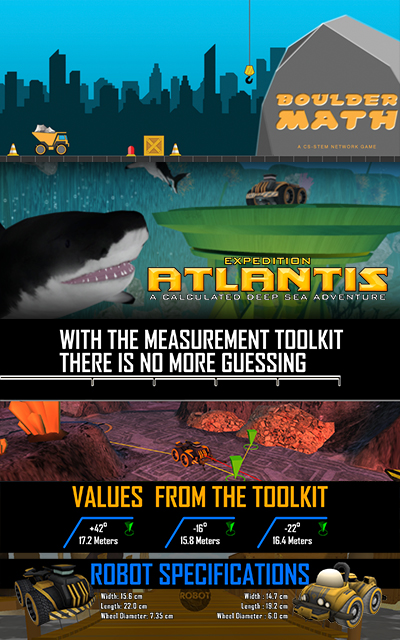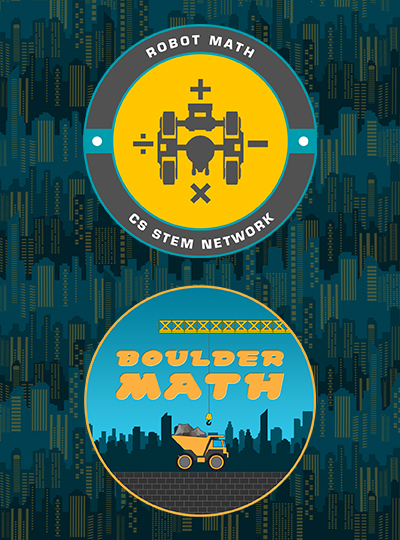Robot Algebra
“This project positions mathematics as a thinking tool.”
Dr. Chris Schunn, University of Pittsburgh, CoPI of project
It is crucial for teachers to develop students’ algebraic thinking and engineering design skills if we are preparing them to compete in the global economy. Algebraic thinking involves identifying patterns, relationships, and functions between one or more objects and being able to find the interrelationships between the variables that make up the objects; it is the beginning of symbolic reasoning. Engineering design skills provide students with a systematized methodology for solving complex problems; it is rigorous creativity. The Robot Algebra project uses classroom-friendly technologies to develop students’ algebraic thinking and reasoning skills by placing them in technology-rich problem-solving situations where they must find the mathematical rule or principle to unlock the solution to the problem and then apply that rule across multiple contexts. The goal of the engineering design portion of the project is to teach students a research-based systematized method for solving engineering design problems. The project places mathematics and design engineering in contexts that students understand, encourages teamwork, integrates a systems ways of thinking, and most importantly makes salient, supports, and connects the math with the engineering design activity.
About
The Robot Algebra Project develops of a set of Design-Based Learning Units (DBL) that use a combination of the motivational effects of robotics, music, dance, and student success, combined with foregrounded mathematics lessons, engineering design, and competition to promote algebra readiness. The project is a partnership between Carnegie Mellon (CMU), the University of Pittsburgh’s Learning Research and Development Center (LRDC), and a consortium of industry, government, foundation, and education partners committed to improving both the quality and quantity of students pursuing science, technology, engineering, and mathematics (STEM) careers.
Across the region and nation, many schools and community-based organizations are proposing to use robotics to address STEM competencies. Yet, our research has found that most teachers miss the key STEM “teaching moments” that a robotics project places into a real-world context. Often, teachers working with the robotics will allow students to be haphazard in their design process, avoid mathematics when possible (e.g., using guess-and-check strategies), which leads to weak solutions and reduces student learning. Building from decades of research on instruction and learning, our project team believes that:
• Robotics provides unique opportunities for teachers to place engineering design and mathematics in contexts that students find engaging and understandable.
• Learning is a cooperative process between the student, the teacher, and the problem; engagement must be present for optimal learning to take place. The choice of the problem is critical if the goal of the problem is to teach STEM.
• Design problems are a natural way of teaching design skills and creating a need-to-know for students to learn math and science. DBLs organize extended curriculum units around design challenges.
• Math is the language of science, engineering, and technology. The mathematics in the lesson needs to be thought throughout by the teacher and foregrounded for the student.
• For STEM education lessons to have a significant impact on a students’ math understanding, the focus of the math instruction must be centered on addressing specific mathematics concepts (not general) and the mathematics in the lesson must be made explicit not implicit.
• For students to obtain a deep understanding of the focal math concepts, connections need to be made between the applied math problem and everyday math situations.
• For students to move beyond parroting the teacher’s words, ideas, and solutions, and develop deep understanding, students need the opportunity to struggle with the problem, be able to defend their decisions, and explain their answer in their own words.
• The ideal STEM curriculum gives students opportunities to solve problems that require them to work cooperatively, to use technology, to address relevant and interesting mathematical ideas, and to experience the power and usefulness of mathematics.
• Curriculum implementation is important. The ability to vary teaching strategies; connect what the learner already knows to what they need to do; and provide individualized feedback for students needs to be taught to teachers.
The Robot Algebra project measures and iteratively improves curriculum that can be implemented in both traditional and non-traditional educational settings.
Initial Robotics Education Research
Over the last two years, CMU and LRDC have been guided by the following questions: “What can we do to improve Robotics’ ability to demonstrate and teach STEM?” and “Can we integrate the successes that LRDC has demonstrated in their science DBLs into CMU’s highly regarded Robotics curricula?”
In year one, we evaluated the mathematic concepts taught in a middle school level robotics curriculum. CMU and LRDC began by performing a content analysis on CMU’s “Introduction to Robotics Engineering, Volume 1” LEGO curriculum, which is currently being used in thousands of classrooms. In this analysis, researchers identified many types of mathematical topics that students would have an opportunity to learn, and investigated the extent to which those topics were aligned with national mathematics standards. They found that the robotics lessons aligned well at the category level, but not as well at the individual math topic level. Simultaneously, the group conducted a case study analysis of an implementation of the robotics curriculum in an eighth grade technology classroom to assess whether mathematics ideas were salient as students were engaged with the tasks. Indeed, when prompted by the teacher during whole-class discussion, students brought in a wide range of formal mathematics ideas. However, because of the multitude and diversity of those ideas (e.g., measurement, algebra, geometry, statistics), we were not able to develop significant gains in math understanding with so little exposure to any one mathematics concept. Similar findings were uncovered during a second test in a ninth grade technology classroom. Our initial research suggests that robotics provides a promising engineering context to teach STEM concepts and that we can use this organizer to teach meaningfully relevant algebraic mathematic concepts in ways that make sense to students but this will take a redesign of the curriculum.
After the end of the first year, the CMU/LRDC team decided that to improve the curriculum’s ability to teach math, that we would need to focus on a narrower set of mathematical principles. The mathematical focus of the Robot Algebra curriculum is to teach ratio and proportion; the ultimate goals of the curriculum are to develop algebraic reasoning skills, support the development of technological literacy, and to teach engineering design to students. We chose ratio and proportion because research supports that these foundational mathematical concepts are not understood by students and these concepts are found in every math class that a student will study from middle school through college. We chose to teach engineering design to provide students with a systematized methodology to solve complex problems. We chose LEGO because of its ease of implementation into the conventional classroom as well as its ability to allow our project to scale. This project will focus, support, and align a set of robotic engineering activities with algebraic concepts that will effectively enable students’ mastery of algebra thinking skills.
Fractions, Ratios, and Proportions
Traditionally, fractions, ratios, and proportions have been considered middle school topics, but testing shows that high school and college students struggle with these foundational mathematics concepts. Fractions, ratios, and proportions are arguably the most mathematically complex and cognitively challenging concepts for students to understand. In addition, ratio and proportion problems can be solved multiple ways, which often leads to student confusion. The Robot Algebra DBLs give students opportunities to work on, struggle with, and eventually solve contextually rich applied ratio and proportion problems. For example, the Dancing Robots unit asks students to create programs that allow a set of physically different robots to dance in synchrony to music. In these lessons, students will learn that there is a linear proportional relationship between:
• Speed and power
• Speed and wheel diameter
• Wheel diameter and distance traveled
• Center to center distance across the robot's wheels and the angle of turn that the robot makes
These proportional relationships, once discovered, give the student programmers the control that they will need to synchronize their robot dances. This DBL presents many teaching moments where the teacher can demonstrate proportional relationships that lead to student understanding.


